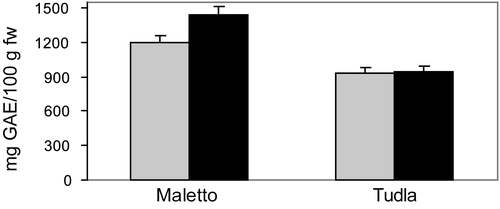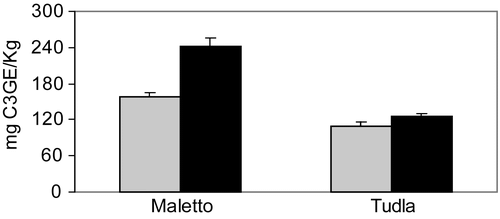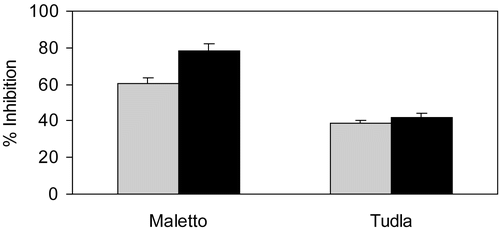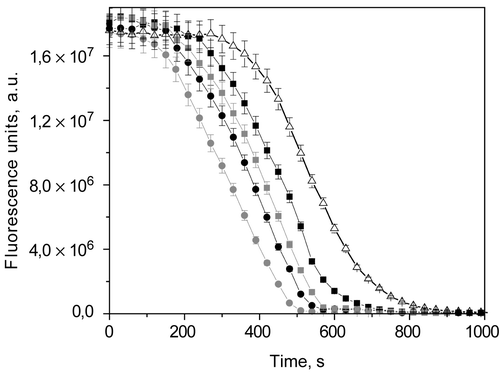Abstract
The aim of this study was to compare the value in phytochemicals and antioxidant activity of two genotypes of strawberry fruit (Fragaria x ananassa, Duchesne, Rosaceae), one represented by the cultivated variety (cv) “Tudla” and the other one, “Maletto”, by a type selected in the mountain region of Etna (Italy). Moreover, we have considered the influence of soil on fruit quality. Total phenolic compounds and antocyanin content were determined by spectrophotometric methods. Phenolics, recovered from pulp juice, were determined by Folin–Ciocalteu method, whereas total anthocyanins were estimated by a pH differential method. Antioxidant activity was evaluated by DPPH and ORAC assays, using quercetin and Trolox as standard respectively.
Our results indicate that the different genotypes of strawberries, in particular those cultivated in volcanic soil of the Etna mountain region, that we call “Maletto” strawberry, could be considered an important resource. They are a good source of antioxidants and could be used to prevent deleterious effects induced by free radicals. The scientific importance of these results may be significant for industry concerning food quality and disease prevention.
Introduction
The benefits resulting from the use of natural products rich in bioactive substances have promoted a growing interest from pharmaceutical, food and cosmetic industries.
It is established that oxidation processes are involved in various chronic and degenerative diseases and that the intake of chemical constituents with antioxidant activity, found in plants in high concentrations, has beneficial effects on health. Phenolic compounds and anthocyanins, two large and heterogeneous groups of biologically active non-nutrients, are known to be dietary components in fruits and vegetables with antioxidant activities. Phenolic compounds are secondary plant metabolites that are widespread in the vegetable kingdom. In strawberries the phenolic compounds are present as ellagic and p-coumaric acid; and the flavonoids as quercetin, kaempferol and myricetin. Anthocyanins consist of a group of phenolic compounds responsible for the red-blue color of many fruits and vegetables. They are glycosylated polyhydroxy or polymethoxy derivatives of 2-phenylbenzopyrylium or flavilium salts (CitationMazza & Miniati, 1993). Pelargonidin 3-glucoside, with cyanidin 3-glucoside and pelargonidin 3-rutinoside are the main anthocyanins found in strawberries.
Several studies have shown that strawberries generally possess a high level of antioxidant activity, which is linked to the levels of phenolic and anthocyanin compounds in the fruit (CitationHeinonen, et al. 1998; CitationVinson, et al. 2001; CitationSun, et al. 2002). Wang and Jiao (Citation2000) showed that strawberry juice exhibited a high level of antioxidant capacity against free radicals, including superoxide radicals, hydrogen peroxide, hydroxyl radicals, and singlet oxygen. Besides, they demonstrated that the percent of inhibition of each active oxygen species varied among the strawberry cultivars. Various analytical methods have been used to evaluate the antioxidant properties of phenolic compounds: the 1,1-diphenyl-2-picrylhydrazyl (DPPH) assay proves the capacity of the antioxidants to quench the DPPH radical, whereas the ORAC method is based on the loss of fluorescence of the β-phycoerythrin protein or of fluorescein upon oxidation (CitationCao, et al. 1993; CitationNinfali, et al. 2005). This latter assay has become a standard method to quantify the antioxidative properties of phytonutrients in fruit and vegetable extract. Recently, this procedure was used to compare the behavior of phenolic compounds (phenolic acids, anthocyanins, flavanols and flavonols) in strawberry juices (CitationAaby, et al. 2005).
The aim of this study is to compare, considering the influence of soil, the antioxidant activity as well as the amount of total polyphenolic and anthocyanins of two genotypes of strawberry (Fragaria 3 ananassa, Duchesne, Rosaceae). These are represented by the cv “Tudla” and “Maletto”, a type selected in the Etna mountain region of Italy (CitationMilella, et al., 2006). ORAC assay (oxygen radical absorbance capacity) and free radical DPPH (1,1-diphenyl-2-picrylhydrazyl) scavenging activity were used to evaluate the antioxidant potential of the strawberry pulp juices with the aim of evaluating subsequently their health benefits and their possible utilization as a source of bioactive compounds.
Fragaria 3 ananassa is the most common variety of strawberry cultivated in the world and different genotypes were developed. The genotype developed in the Etna mountain region and cultivated in Maletto (Catania, Italy) is usually known as the “Maletto” strawberry. This is a medium-small fruit, with a light red color and with a greenish end, an extraordinarily intense and aromatic fragrance.
The fruit samples were obtained from a commercial plantation (Tudla) and from a plantation that cultivates fruits by applying conventional farming practice (Maletto). The influence of some soil types on the total polyphenolic amount of fruits was also considered.
The particular volcanic soils in Etna valley may also strongly influence fruit growth and quality, distinguishing these particular fruits from other commercial strawberries. Indeed, volcanic soils are characterized by large amounts of carbon and alumina incorporated in non-crystalline aluminosilicates and Al-humus complexes (CitationShoji et al., 1993). This may strongly influence soil moisture and nitrogen and phosphorus supply (CitationBoudot & Chone, 1985), influencing in turn growth, species composition and ecosystem biodiversity.
Materials and methods
Plant material
For genotype and authenticity see Milella et al. (Citation2006). The Tudla and Maletto strawberries were grown in May-June by professional farmers from a plantation at 960 m above sea level, on the northern side of Mount Etna in Sicily near Catania. Agronomic practices were in accordance with standard recommendations for commercial plantations. The fruits were picked in May from one-year-old plants.
Strawberry samples
Randomly collected fruits were stored at a relative humidity of 95% at 18 ± 2°C until arrival to the laboratory. The fruits were squeezed manually under ice, filtered with a sieve and centrifuged for 5 min at 500 g.
Phenolic content of fruit was determined in fresh filtered juice; other analyses were performed on strawberries stored at 25 ± 2°C.
All studied samples were obtained from Maletto (Etna valley, Catania, Italy), i.e. from a mountain plantation and from a plantation near Simeto river. They were divided into four groups:
Tudla cultivated undergrowth in volcanic soil
Tudla cultivated in a mixture of silt-clay soil
Maletto cultivated undergrowth in volcanic soil
Maletto cultivated in a mixture of silt-clay soil
Chemicals
Folin-Ciocalteu phenol reagent and all other chemicals were purchased from Sigma Aldrich (Milano, Italy).
Determination of total phenolics
The phenol content was measured by the Folin-Ciocalteau reagent (CitationAaby et al., 2005; CitationSingleton & Rossi, 1965) using gallic acid as standard. The whole juice (1 mL) was mixed with 5 mL Folin-Ciocalteau reagent (previously diluted 10-fold with distilled water) and 4 mL sodium bicarbonate (7.5% w/v), and the mixture was diluted to 100 mL with distilled water. The solution was kept in the dark at room temperature for 2 h; the absorbance was then measured at 765 nm with a model UV-2401 PC spectrophotometer (Shimadzu, Milano, Italia). Total phenolic content was expressed as gallic acid equivalents (the concentration of gallic acid was established from a calibration curve) in mg per 100 g fresh weight (mg GAE/100 g fw).
Determination of total anthocyanins
Total anthocyanin contents of the samples were determined using the pH-differential method described by Rapisarda et al. (Citation1994). The pH values of the diluted pulp juice were 1.0 (in 0.025 M potassium chloride buffer) and 4.5 (in 0.4 M sodium acetate buffer), respectively. Absorbance was measured using a spectrophotometer at 510 nm and at 700 nm.
The absorbance values of the diluted samples (A) were calculated as follows:
The total anthocyanin pigment (TA) was calculated as follows:
The result, considered as the total anthocyanin content, was calculated as mg cyanidin-3-glucoside equivalent per kg dry extract (mg C3GE/Kg) by using (A) the difference of absorbance between pH 1 and pH 4.5 solutions, dilution factor (df), conversion factor to kg (1000), a molar absorptivity (ε) of 24,825 M−1 cm−1 (at 510 nm) and a molecular weight (MW) of 484.82.
ORAC assay
The original method (CitationCao et al., 1993) with a few modifications (CitationNinfali et al., 2005), was used. The final reaction mixtures for the assay were prepared as follows:
blank solution: 0.075 M sodium phosphate buffer, pH 7.
Trolox solution: 300 μL 50 μM Trolox, 45 mg AAPH and 2700 μL 0.05 μM fluorescein sodium salt in 0.075 M sodium phosphate buffer, pH 7.
Sample: 10 μL whole strawberries juice, 290 μL 0.075 M sodium phosphate buffer, pH 7, 45 mg AAPH and 2700 μL 0.05 μM fluorescein sodium salt in 0.075 M sodium phosphate buffer, pH 7.
Control solution: 2700 μL 0.05 μM fluorescein sodium salt in 0.075 M sodium phosphate buffer, pH 7 and 45 mg AAPH (data not shown).
Fluorescence emission was read every 30 s at 37°C using a spectrofluorometer Fluorolog-3 (Spex-Jobin Yvon) (excitation 485 nm, emission 520 nm). The ORAC value was expressed as μmol Trolox equivalent per 1 g fresh weight (μmol TE/g fw) and was calculated according to the formula:
where AUCs in the area under the curve of fluorescein in the sample, calculated with the ORIGIN 6.0 program (Microcal Software), AUCT is the area under the curve of the Trolox, AUCb in the area under the curve of the blank, h is the ratio between the liters of juice and the grams of fruit, k is the dilution factor and c is the concentration of the Trolox in μmol/L.
DPPH assay
The 1,1-diphenyl-2-picrylhydrazyl radical (DPPH •) has been widely used to evaluate the free radical scavenging activity of natural antioxidants (CitationBrand-Williams et al., 1995; CitationSorrenti et al., 2006). In this study aliquots of the whole strawberry juice were mixed with an ethanol solution of DPPH • (3 mM), namely 2.37 mg DPPH • in 2 mL ethanol. For the sample solution, 28 μL whole juice was mixed with 28 μL DPPH • solution and 944 μL ethanol. After incubation in the dark at room temperature for 10 min, the spectrophotometric determination was assayed at 515 nm using a model UV-2401 PC spectrophotometer (Shimadzu, Milano, Italia). A freshly prepared DPPH • blank solution (containing 972 μL ethanol and 28 μL DPPH • solution) was used. The DPPH • solution was stored in a flask covered with aluminum foil, and kept in the dark at 4°C between measurements. The percentage decrease in absorbance was recorded for each sample, and percentage quenching of DPPH • radical was calculated on the basis of the observed decrease in absorbance according to the formula:
where A0 is the absorbance value of the DPPH • blank solution and A1 is the absorbance value of the sample solution.
Statistics
Statistical analysis was carried out using ANOVA with significance level set at p <0.05.
Differences among means were evaluated using a statistical program. All experiments were carried out in triplicate and repeated at least twice.
Results
Total phenolic content
shows the concentration of phenolic compounds identified in Tudla and Maletto strawberries. The fruits were grown in both volcanic (undergrowth) and in a mixture of silt-clay soil (near Simeto River).
Maletto strawberries, in particular those grown in volcanic soil, had the highest total phenolic content, ranging between 1197 and 1441 mg GAE/100 g fw, whereas values for Tudla strawberries were lower and not affected by soil composition.
Figure 1. Concentration of phenolic compounds (mg GAE/100 g fw) in Maletto and Tudla strawberries grown in a mixture of silt-clay soil (gray bar) and in volcanic soil (black bar). Means with error bars are reported. The experiments were carried out in triplicate and repeated at least twice, significantly different by ANOVA with p <0.05.

Total anthocyanins
The content of total anthocyanins in Tudla and Maletto strawberries was investigated with respect to soil composition. As reported in , the anthocyanin content was higher in Maletto strawberries. As for phenolic compound evaluation, for both genotypes the presence of volcanic soil is accompanied by an increase of the amount of antioxidant content, with a marked difference for Maletto strawberry, but the Tudla strawberries showed only a slight difference with respect to soil composition.
Figure 2. Concentration of anthocyanins (mg C3GE/Kg) in Maletto and Tudla strawberries grown in a mixture of silt-clay soil (gray bar) and in volcanic soil (black bar). Means with error bars are reported. The experiments were carried out in triplicate and repeated at least twice, significantly different by ANOVA with p <0.05.

Figure 3. Antioxidant activity by DPPH assay in Maletto and Tudla strawberries grown in a mixture of silt-clay soil (gray bar) and in volcanic soil (black bar). Means with error bars are reported. The experiments were carried out in triplicate and repeated at least twice, significantly different by ANOVA with p <0.05.

Figure 4. Antioxidant activity by ORAC assay in Maletto and Tudla strawberries grown in a mixture of silt-clay soil (gray bar) and in volcanic soil (black bar). Means with error bars are reported. The experiments were carried out in triplicate and repeated at least twice, significantly different by ANOVA with p <0.05.

Antioxidant activity
Effects similar to those observed for phenolic compounds and anthocyanin evaluation are also revealed by antioxidant activity measurements. Results are shown in for DPPH assay, and in for ORAC assay (relative kinetics are reported in ). Maletto strawberry samples showed the highest antioxidant activity, at 53.5 μmol Trolox equivalents/g fresh weight for ORAC assay and 78.24% inhibition for DPPH assay. Tudla strawberries achieved a value of 38.4 μmol TE/g fw by ORAC assay and 41.8% inhibition for DPPH assay. In both assays only a slight difference with respect to soil composition was observed in from Tudla strawberries.
Figure 5. Typical quenching curves obtained in antioxidant activity from ORAC assay: Fluorescence decay of 0.05 μM fluorescein with A) 4.92 mM AAPH and 12.5 μM Trolox (-Δ-); B) 4,92 mM AAPH in the presence of the juices of selected strawberries grown in different soil types: Maletto (–) and Tudla (-O-) strawberries cultivated in mixture of silt-clay soil (gray) and in volcanic soil (black).

Discussion
The present study was carried out to evaluate the antioxidant activity, total polyphenolic and anthocyanins content of two genotypes of Fragaria 3 ananassa, the former represented by the cv Tudla and the latter by a type selected from the Etna mountain region. This allows verification of an important genetic resource and a potential application in health promotion and disease prevention against radical mediated oxidative damage.
Moreover, the characterization of the bioactive factors is required to provide scientific evidence for improving quality and nutritional value for the human diet. In strawberries cultivated in Maletto, the anthocyanin content ranged from 157 to 243 mg C3GE/Kg for Maletto strawberries and about 120 mg C3GE/Kg for Tudla strawberries, and the total phenolic content ranged from 1197 to 1441 mg GAE for Maletto strawberries and was about 1240 mg GAE for Tudla strawberries ( and ).
These bioactive compounds are of prominent importance, in fact anthocyanin pigments constitute an integral part of the sensory attributes and contribute directly to the coloration of the strawberries. Anthocyanins were claimed to possess diverse biological properties and therefore are considered as secondary metabolites with a potential nutritional value. Maletto strawberries were demonstrated to be very rich in anthocyanins (CitationMilella et al., 2006), and their accumulation in strawberries is strongly influenced by environmental conditions such as temperature, light intensity and soil composition. Indeed, the fertile volcanic soil surely contributes to their relatively high anthocyanin content. Anthocyanins are considered very good antioxidant agents, their high activity being attributed to their peculiar structure, namely the oxonium ion in the C ring (CitationVan Acker et al., 1995). In some small fruits (CitationMoyer et al., 2002), the antioxidant capacity has been correlated to a significant degree with anthocyanin content, indicating that anthocyanins may govern to a certain extent the antioxidant capacity of several plant tissues. Phenolic phytochemicals with antioxidant properties are now believed to be an important component in fruits and vegetables responsible for beneficial health effects. Populations consuming diets rich in fruits and vegetables were shown to have lower incidences of many oxidation-linked chronic diseases such as cancer, cardiovascular diseases and diabetes. Effectiveness of phenolic antioxidants in protecting against oxidative stress is mainly due to their redox properties, which allow them to act as reducing agents, hydrogen donors and singlet oxygen quenchers. Maletto strawberries are a good source of dietary antioxidants thanks to their high level of phenolic compounds. The reason of this peculiarity comes from the particular environmental niche where they are grown and from which they take their properties. The volcanic soil where these strawberries are cultivated, and the particular environmental conditions which characterize the Etna valley, are the only parameters that distinguished this product in an unambiguous way, thus contributing to the increase of the antioxidant capacity.
Our findings indicate that there were significantly greater concentrations of both phenolic compounds and total anthocyanins in the strawberry fruits cultivated in volcanic soil, and that the genotype having relatively high concentrations of antioxidative phytochemicals is Maletto strawberry. Moreover, these fruits cultivated in volcanic soil have the highest values compared with the other samples (Tudla). Consequently, this strawberry exhibited the highest antioxidant capacity, as demonstrated by the scavenging activity shown in DPPH and then confirmed ORAC assays. This led us to suppose that the fertile volcanic soil, with its high mineral content, together with a warm climate and plentiful water resources, provides an ideal growing environment, producing high stores of phenols and anthocyanins, and consequently increasing antioxidant capacity.
The different quantity of phenolic and anthocyanin compounds, and consequently the different antioxidant activity, confirms the theory that the type of cultivation is important for antioxidant capacity in strawberries. The Tudla strawberries have lowest values in absolute and this result could be mainly due to the different genomic characteristics (CitationMilella et al., 2006).
Conclusions
Concentrations of nutrients and bioactive substances (flavonols, anthocyanins, ellagic acid, etc.) are known to be strongly influenced by extrinsic factors such as variations in plant type and growth, climate, season, temperature, as well as degree of ripeness (CitationWeisburger, 1999). Our data show that the strawberries tested, especially Maletto strawberries, are a good source of both nutrients and bioactive compounds, especially phenolics. The scientific importance of these results could be significant for industry concerning food quality and disease prevention.
Acknowledgments
Financial support from the following institutions is gratefully acknowledged: the Italian MURST, in the framework of the Progetto di ricerca di Ateneo 2005 Università degli Studi di Catania and L.AG.AM.ESA-CT, Laboratorio Agrochimico-Ambientale dell’Ente di Sviluppo Agricolo di Catania.
Declaration of interest: The authors report no conflicts of interest. The authors alone are responsible for the content and writing of the paper.
References
- Aaby K, Skrede G, Wrolstad RE (2005): Phenolic composition and antioxidant activities in flesh and achenes of strawberries (Fragraria ananassa). J Agric Food Chem 3: 4032–4040.
- Brand-Williams W, Cuvelier ME, Berset C (1995): Use of a free radical method to evaluate antioxidant activity. Lebensm Wiss Technol 26: 25–30.
- Boudot JP, Chone T (1985): Internal nitrogen cycling in two humic-rich acidic soils. Soil Biol Biochem 17: 135–142.
- Cao G, Alessio HM, Culter RG (1993): Oxygen-radical absorbance capacity assay for antioxidants. Free Radic Biol Med 14: 303–311.
- Heinonen MI, Meyer AS, Frankle EN (1998): Antioxidant activity of berry phenolics on human low-density lipopreotein and liposome oxidation. J Agric Food Chem 46: 4107–4112.
- Kuhnau J (1976): The flavanoids. A class of semi-essential food components: Their role in human nutrition. World Rev Nutr Diet 24: 117–191.
- Mazza G, Miniati E (1993): Anthocyanins in Fruits, Vegetables, and Grains. Boca Raton, CRC Press, pp. 362–366.
- Milella L, Saluzzi D, La Pelosa M, Bertino G, Spada P, Greco I, Martelli G (2006): Relationships between an Italian strawberry ecotype and its ancestor using RAPD markers. Genet Resour Crop Evol 53: 1715–1720.
- Moyer RA, Hummer KE, Finn CE, Frei B, Wrolstad RE (2002): Anthocyanins, phenolics, and antioxidant capacity in diverse small fruits: Vaccinium, Rubus, and Ribes. J Agric Food Chem 50: 519–525.
- Ninfali P, Mea G, Giorgini S, Rocchi M, Bacchiocca M (2005): Antioxidant capacity of vegetable, spices, dressing relevant to nutrition. Br J Nutr 93: 257–266.
- Rapisarda P, Fallico B, Izzo R, Maccarone E (1994): A simple and reliable method for determining anthocyanins in blood orange juices. Agrochim 38: 157–164.
- Shoji S, Nanzyo M, Dahlgren R (1993): Productivity and utilization of volcanic ash soils. In: Shoji S, Nanzyo M, Dahlgren R, eds., Volcanic Ash Soils: Genesis, Properties and Utilization. Amsterdam, Elsevier, pp. 209–251.
- Singleton VL, Rossi JA (1965): Colorimetry of total phenolics with phosphomolybdic-phosphotungstic acid reagents. Am J Enol Vitic 16: 144–158.
- Sorrenti V, Salerno L, Di Giacomo C, Acquaviva R, Siracusa MA, Vanella A (2006): Imidazole derivates as antioxidants and selective inhibitors of nNOS. Nitric Oxid 14: 40–45.
- Sun J, Chu YF, Wu X, Liu RH (2002): Antioxidant and antiproliferative activities of common fruits. J Agric Food Chem 50: 7449–7454.
- Van Acker SA, Tromp MN, Haenen GR, Van Der Vijgh WJ, Bast A (1995): Flavonoids as scavengers of nitric oxide radical. Biochem and Biophys Res Comm 214: 755–759.
- Vinson JA, Su X, Zubik L, Bose P (2001): Phenol antioxidant quantity and quality in foods: Fruits. J Agric Food Chem 49: 5315–5321.
- Wang SY, Jiao H (2000): Scavenging capacity of berry crops on superoxide radicals, hydrogen peroxide, hydroxyl radicals, and singlet oxygen. J Agric Food Chem 48: 5677–5684.
- Weisburger JH (1999): Mechanisms of action of antioxidant as exemplified in vegetable, tomatoes, and tea. Food Chem Toxicol 37: 943–948.